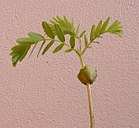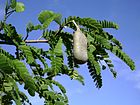Note: This is a project under development. The articles on this wiki are just being initiated and broadly incomplete. You can Help creating new pages.
Tamarindus indica - Amalika
Tamarind is a long lived and beautiful fruiting tree, growing up to 30 metres tall with a dense, spreading crown. The tree has fragrant flowers and a feathery foliage that is usually evergreen but becomes deciduous in drier regions.
Contents
- 1 Uses
- 2 Parts Used
- 3 Chemical Composition
- 4 Common names
- 5 Properties
- 6 Habit
- 7 Identification
- 8 List of Ayurvedic medicine in which the herb is used
- 9 Where to get the saplings
- 10 Mode of Propagation
- 11 How to plant/cultivate
- 12 Commonly seen growing in areas
- 13 Photo Gallery
- 14 References
- 15 External Links
Uses
Sores, Ulcers, Boils, Rashes, Asthma, Cardiac, Blood sugar, Throat infection, Cough, Fever. Intestinal worms
Parts Used
Chemical Composition
It contains essential oils, free and conjugated fatty acids, flavonoids, and other compounds, but also describe the presence of eight new compounds for this part of the plant and important levels of Selenium and other micro-elements not previously reported.[1]
Common names
| Language | Common name |
|---|---|
| Kannada | Hunuse mara |
| Hindi | Ambli, Amili |
| Malayalam | Amlika, Valampuli |
| Tamil | Yukini, Yukinimaram |
| Telugu | Tintrini, Tintrinikamu |
| Marathi | Aambali, Aamli |
| Gujarathi | |
| Punjabi | |
| Kashmiri | |
| Sanskrit | Umblee, Vrksamla, Amalika |
| English | Indian date, Tamarind |
Properties
Reference: Dravya - Substance, Rasa - Taste, Guna - Qualities, Veerya - Potency, Vipaka - Post-digesion effect, Karma - Pharmacological activity, Prabhava - Therepeutics.
Dravya
Rasa
Tikta (Bitter), Kashaya (Astringent)
Guna
Veerya
Vipaka
Karma
Prabhava
Habit
Identification
Leaf
| Kind | Shape | Feature |
|---|---|---|
| Paripinnate | Oblong | Leaf Arrangementis Alternate-spiral |
Flower
| Type | Size | Color and composition | Stamen | More information |
|---|---|---|---|---|
| Unisexual | 2-4cm long | Pink | Flowering throughout the year and In terminal and/or axillary pseudoracemes |
Fruit
| Type | Size | Mass | Appearance | Seeds | More information |
|---|---|---|---|---|---|
| Oblong pod | Thinly septate, pilose, wrinkled | Seeds upto 5 | Fruiting throughout the year |
Other features
List of Ayurvedic medicine in which the herb is used
Where to get the saplings
Mode of Propagation
How to plant/cultivate
Tamarind grows best in drier areas of the tropics, though it can also do well in much wetter, monsoon areas so long as there is a distinct dry season. [4]
Commonly seen growing in areas
Low-altitude woodland area, Savannah area, Termite mounds, Semi-arid areas, Wooded grassland. Stream and riverbanks
Photo Gallery
References
- ↑ Chemical constituents
- ↑ [Morphology]
- ↑ Ayurvedic preparations
- ↑ Cultivation detail
External Links
- Ayurvedic Herbs known to be helpful to treat Sores
- Ayurvedic Herbs known to be helpful to treat Ulcers
- Ayurvedic Herbs known to be helpful to treat Boils
- Ayurvedic Herbs known to be helpful to treat Rashes
- Ayurvedic Herbs known to be helpful to treat Asthma
- Ayurvedic Herbs known to be helpful to treat Cardiac
- Ayurvedic Herbs known to be helpful to treat Blood sugar
- Ayurvedic Herbs known to be helpful to treat Throat infection
- Ayurvedic Herbs known to be helpful to treat Cough
- Ayurvedic Herbs known to be helpful to treat Fever
- Ayurvedic Herbs known to be helpful to treat Intestinal worms
- Herbs with Stem used in medicine
- Herbs with Leaves used in medicine
- Herbs with Roots used in medicine
- Herbs with common name in Kannada
- Herbs with common name in Hindi
- Herbs with common name in Malayalam
- Herbs with common name in Tamil
- Herbs with common name in Telugu
- Herbs with common name in Marathi
- Herbs with common name in Sanskrit
- Herbs with common name in English
- Habit - Evergreen tree
- Index of Plants which can be propagated by Seeds
- Herbs that are commonly seen in the region of Low-altitude woodland area
- Herbs that are commonly seen in the region of Savannah area
- Herbs that are commonly seen in the region of Termite mounds
- Herbs that are commonly seen in the region of Semi-arid areas
- Herbs that are commonly seen in the region of Wooded grassland
- Herbs that are commonly seen in the region of Stream and riverbanks
- Herbs
- Ayurvedic herbs that don't have seed photos
- Fabaceae







